|
|
|
|

Suijin 水神, Suiten 水天, Sui-ō 水王
Deity of the Water, the Sea, and Fishing Folk
Deity of Fertility, Motherhood, Children, Easy Delivery
OTHER NAMES: Mizu no Kamisama, Kuni no Kotachi
ORIGIN = JAPAN (but with Buddhist & Hindu counterparts)
Also see Patrons of Motherhood & Children in Japan
|
|
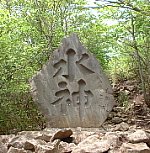
SUIJIN
Stone Marker on
trail at Izumigatake
in Sendai Area.
|
|
The term Suijin (literally water kami or water deity) refers to the many heavenly and earthly manifestations of the benevolent Shintō divinity of water. But it also refers to a wide variety of mythological and magical creatures found in lakes, ponds, springs and wells, including serpents (snakes and dragons), eels, fish, turtles, and the flesh-eating kappa.
These lesser Suijin-creatures should not be confused with the benevolent Suijin (aka Mizu no Kamisama 水の神様, lit. = Water Kami), guardian of fishing folk, and patron of fertility, motherhood, and easy childbirth. This Shintō divinity is widely worshipped at Suitengū Shrines 水天宮 throughout Japan, and votive stone markers devoted to her can be found frequently in the countryside. The Suitengū Shrine in Kurume 久留米 (Fukuoka Prefecture) is the main shrine of all Suitengū Shrines in Japan. It is especially famous to those praying for safe and easy childbirth.
In Japan, most Suijin are enshrined near rice paddy fields, irrigation canals, mountain streams, rivers, agricultural waterways, household wells, and even inside sewage water and septic tanks. Says the Encyclopedia of Shintō (Kokugakuin University): "In some cases, water kami may be enshrined as 'water distributing kami' (Mikumari no Kami 水分神) at the mountain springs forming the sources of agricultural waterways, in which case they may also be associated with the kami of the mountain (Yama no Kami 山の神)." <end quote> However, the many small shrines and stone markers dedicated to Suijin rarely show the deity anthromorphically.
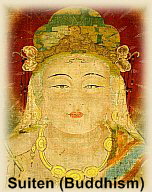 Not surprisingly, Mizu no Kamisama was appropriated by the Buddhist camp after Buddhism was introduced to Japan in the 6th century AD. The Buddhist equivalent, named Suiten (literally "water deva") is one of the 12 Deva. Suiten (Skt. = Varuna) is the lord of oceans and rivers, and is typically positioned in the west (or southwest) in Japanese mandala paintings. This Buddhist version, of Vedic origin, is rarely the central object of devotion in Japan. Not surprisingly, Mizu no Kamisama was appropriated by the Buddhist camp after Buddhism was introduced to Japan in the 6th century AD. The Buddhist equivalent, named Suiten (literally "water deva") is one of the 12 Deva. Suiten (Skt. = Varuna) is the lord of oceans and rivers, and is typically positioned in the west (or southwest) in Japanese mandala paintings. This Buddhist version, of Vedic origin, is rarely the central object of devotion in Japan.
Mizu no Kamisama (aka Suijin) also shares many of the attributes associated with the Shintō-Buddhist Goddess Benzaiten (also a water deity), and with the Buddhist savior Kannon Bosatsu (Goddess of Compassion), who is often connected with motherhood and easy childbirth in her manifestations as Juntei Kannon (Skt. = Cundi, the "mother of the Buddhas"), Jibo Kannon and Koyasu Kannon. In addition, there are many other important water kami (deities) in the Japanese pantheon. This page presents my notes on some of Suijin's many manifestations in Japan. I would like to thank Dr. Gabi Greve
References: Dr. Gabi Greve, SUIJIN God of Water
Gabi also writes that one of the most curious forms of Suijin is said to manifest itself inside sewage water. See story here. for helping me with my research on this topic. MAJOR DEITIES OF WATER IN JAPAN'S PANTHEON
- Mizu no Kamisama 水の神様; Shintō Water Goddess / God, Water Kami; also called Suijin 水神 or Suiten 水天 or Sui-ō 水王. MIZU 水 means water; KAMISAMA 神様 means god / goddess / lord / great honorable one. Mizu no Kamisama is worshipped widely throughout Japan, and shrines dedicated to this deity are called Suitengū shrines 水天宮. Votive stone markers for Mizu-no-Kamisama can be found in caves, near rice paddies, and near village boundaries. Farmers in mountainous regions in particular pray to this deity to keep their fields alive with water, or to spare the village from too much rain, which could kill the crops or cause mudslides. Other names include:
- Suijin 水神 lit. "water kami." SUI 水 = water, JIN, KAMI, or SHIN 神 = god or goddess.
- Suiten 水天, lit. "water deva." SUI 水 = water, TEN 天 = deva or heaven. (Buddhist)
- Sui-ō 水王, lit. "water king." SUI 水 means water, and Ō 王 means king.
-
|
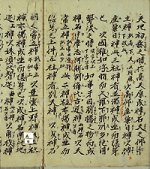
Ame-no-Minakanushi
天御中主大神
Deity name recorded
in the Kojiki (712 AD).
Courtesy Suitengu
Shrine in Tokyo
www.suitengu.or.jp
|
|
Japan's numerous Suitengū shrines (since at least the early modern period) believe that manifestations of the Water Deity in Japan stem from one central, eternal, universal, and imminent divinity named Ame no Minakanushi 天御中主大神, the first deity of creation in the Kojiki. This deity's name is typically translated as Lord of the Center of the Sky, or Chief of All Celestial Deities, for Ame no Minakanushi has served as the chief kami of the seven stars of the the Little Dipper (Ursa Minor) since the Meiji Period (1868-1912), when the government forcibly separated Shintō and Buddhism (Shinbutsu Bunri 神仏分離). Before then, the Buddhist deity Myōken (deification of the Pole Star) served this role. For more details on Ame no Minakanushi, click here.
Between 1868-1875, when the government actively outlawed all fusion of the Kami-Buddha, the Buddhist deity Myoken was commonly replaced with the Shinto kami Ame no Minakanushi no Mikoto (a primordial ancestral kami), who then served as the chief kami of the seven major stars of the constellation of the BIg Dipper (Ursa Major). Ame no Minakanushi is generally translated as Lord of the Center of the Sky. This kami appears in the Kojiki (Record of Ancient Matters, 712 AD, Japan's oldest record of its creation myths), and from 12th-century texts onward, the deity is generally interpreted as equivalent to the Pole Star. The deity is also known as Amenominakanushi, Amanominakanushi, Amaterasu. Sources: Kokugakuin University and Mark Teeuwen, p. 92.
Says the Encyclopedia of Shinto: "Japanese scholar Hirata Atsutane, in particular, propounded a theology wherein Ame no Minakanushi no Mikoto was chief kami of the seven major stars of the constellation Ursa Major. As a result of this influence, Ame no Minakanushi was made a central deity at the Daikyo-in Temple in the early Meiji period, and he was worshiped within sectarian Shinto (Kyoha Shinto) as well. During the process of separation of Shinto and Buddhist objects of worship, the deity Myoken (the north star) was changed to Ame no Minakanushi at many shrines. Many Suitengu shrines throughout modern Japan still revere Amenominakanushi -- which can be roughly translated as "Chief of All Celestial Deities," thus retaining the nuance of Myoken's exalted position among all stars. For an excellent review of Myoken in modern times, see story by scholar Gaynor Sekimori entitled "Star Rituals and Nikko Shugendo" appearing in The Worship of Stars in Japanese Religious Practice, pages 217-250, edited by Lucia Dolce; a special double issue of Culture and Cosmos, ISSN 1368-6534. In the same double-issue, scholar Mark Teeuwen, p. 92, says: "At Ise shrines, from the 12th century onwards, Ise priests wrote texts claiming that the deity of the Outer Shrine at Ise was identical to Ame no Minakanushi (the first deity of creation in the Kojiki)."
Dr. Gabi Greve, SUIJIN God of Water
Gabi also writes that one of the most curious forms of Suijin is said to manifest itself inside sewage water. See story here.
- Uijini, Suijini, Suijini no Kami, Uijine no Mikoto, Suijine no Mikoto, 宇比地邇神 ・ 須比智邇神(記)、埿土 煑 (根)尊 ・ 沙土 煑 (根)尊(紀). See Uijini, Suijini entry at the Encyclopedia of Shintō (Kokugakuin University) for details.
- Kuraokami no kami 闇淤加美神 ・水の神 ・龍神様 (dragon tutelary of water; see Munakata).
Also see Kuraokami entry at the Encyclopedia of Shintō (Kokugakuin University) for details.
- Takaokami no kami (Kojiki) 高淤加美神 ・水の神 ・龍神様 (dragon tutelary of water; another name for Kuraokami). See Takaokami entry at Encyclopedia of Shintō (Kokugakuin University).
- Mitsuha or Kuramitsuha 罔象女神 ・水を司る神 ・雨乞いの神 (see Munakata below)
Also see Kuramitsuha entry at Encyclopedia of Shintō (Kokugakuin University) for details.
- Suijin 水神. See Suijin entry at Encyclopedia of Shintō (Kokugakuin University) for details.
- Benzaiten 弁財天. A water goddess. One of Japan's most popular divinities and the sole female among Japan's beloved Seven Lucky Gods. She is also one of Japan's most complex syncretic deities, having long ago been conflated with other deities from the Hindu, Buddhist, and Japanese pantheons. Her worship in Japan is widespread in Buddhist, Shugendō, and Shintō circles. She was adopted into the Buddhist pantheon of Japan around the 8th century AD as an eight-armed weapon-wielding defender of Buddhism and the nation. During the 12th-13th centuries, she evolved into a beautiful water goddess and patroness of learning, art, and music (of "things that flow"). Benzaiten is also identified with numerous kami (deities), including Itsukushima-hime 市寸島比売命 (the Shintō goddess of islands venerated at Itsukushima Shrine, a Benzaiten stronghold in Hiroshima), and the three Munakata water goddesses 胸形三女神 worshipped at some 6,000 Munakata shrines nationwide. When the government forcibly separated Shintō and Buddhism in the latter half of the 19th century, those who joined the Shintō camp stressed these identifications, allowing them to continue worshipping the quasi-Buddhist deity Benzaiten in her Shintō manifestations. Her places of worship number in the thousands and are often located near water, the sea, a lake, a pond, or a river. See the Benzaiten page for details.
-
|
|
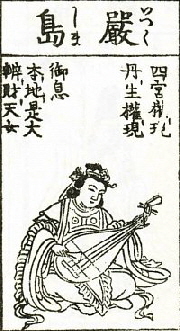
Itsukushima 厳島. The most important
of the Three Munakata Goddesses.
Shown here as she appears in the
1783 version of the Butsuzō-zui.
Click image to see enlarged versions
from both the 1690 and 1783 editions.
|
|
Munakata Shrines 宗像 and Munakata Taisha 宗像大社. Munakata Taisha in Munakata City (Fukuoka) is the mother shrine for some 6,000 satellite Munakata shrines nationwide. <Source: Encyclopedia of Shinto> Munakata shrines are dedicated to the Munakata Sanjoshin 宗像三女神 (or 胸形三女神), the "Three Female Kami of Munakata." These three are water goddesses, island kami, and patrons of safety at sea, bountiful fishing, guarding the nation, and protecting the imperial household. The trio appear in the Kojiki 古事記 (K) and Nihon Shoki 日本書紀 (NS), two of Japan's earliest official records of the 8th century, although the spelling of their names differ slightly. In the 8th and 9th centuries, Japanese envoys to China visited Munakata Taisha before their departure to pray for safety on the sea voyage. In the classical texts mentioned above, all three kami were formed when sun goddess Amaterasu broke Susanō's sword, chewed it in her mouth, then blew out a mist that produced the triad <see story>. The three kami are:
- Ichikishima-hime 市杵嶋姫命 (NS) or Itsukishima-hime 市寸島比売命 (K), or Ichikishima Hime-no-Kami 市杵島姫神, or Sayoribime no Mikoto 狭依毘売命 (K). Enshrined at Hetsumiya (Hetsu-gū ) 辺津宮 in Munakata City, Fukuoka. Also known as Itsukushima Myōjin 厳島明神 at Itsukushima Shrine 厳島神社 (Hiroshima), where she appeared in the late Heian period and was enshrined as the central object of worship and also identified as a manifestation of Benzaiten. Ichikishima-hime is the most important of the three Munakata goddesses. In some shrines she is shown alone yet represents all three.
- Tagitsu-hime 多岐都比売命 (K) or 湍津姫 (NS). Enshrined at Nakatsumiya (Nakatsu-gū) 中津宮 on Ōshima island 大島, roughly ten kilometers from land. In some esoteric traditions, she is considered the goddess of architecture and forestry. <source page 390>
- Tagori-hime 田心姫 (NS) or Tagiri-hime [Takirihime] 多紀理毘売 (K), or 田心姫神. Also known as Okitsushima-hime 奥津島比売命. Her main shrine is Okitsumiya (Okitsu-gū) 沖津宮 on Okinoshima island 沖ノ島 at the southwestern tip of the Sea of Japan. Surprisingly, the island is off limits to women -- a tradition that started early on. In the Kojiki, she marries Ōkuninushi 大国主命 (great landlord kami; identified with Daikokuten, Buddhist deity of agriculture). Tagori-hime has a male manifestation known as Shōshinji Gongen 聖真子権現 (also read Shōshinshi), who is the 19th member of the 30 Kami of 30 Days; he is venerated at Mt. Hiei (the third shrine at Mt. Hiei is Shōshinji 聖真子 or Usamiya 宇佐宮). In some esoteric traditions, Tagori is the kami of agriculture & weaving. <source page 390>.
NOTE 1
Note: Scholar Richard Thornhill provides this illuminating passage: "From ancient times, Benzaiten has been identified with the Shinto goddess of islands, Itsukushima-Hime or Ichikishima-Hime, a minor figure in the oldest Shinto scriptures. In 1870, Shinto and Buddhism were legally separated, and the Shinto clergy have thus stressed this identification so as to continue worshipping Benten at Shinto shrines. In the Rig Veda, Sarasvati is viewed as one of a trinity of goddesses, together with Ila and Bharati or Mahi. In the Shinto classics, Itsukushima-Hime is one of a trinity of water goddesses, together with Tagori-Hime and Tagitsu-Hime, all of whom were formed from the sword of the Sun Goddess Amaterasu." <end quote by Richard Thornhill; last accessed Aug. 29, 2010>
NOTE 2
Other Names for the Three Munakata Water Goddesses include Kuraokam no Kami 闇淤加美神, Takaokami no Kami 高淤加美神, and Kuramitsuha 罔象女神. Above three links go to the Encyclopedia of Shintō (Kokugakuin University).
SOURCES
Encyclopedia of Shinto: Munakata | Ichikishima-hime | Tagori-hime | Tagitsu-hime
Also see Gabi Greve, Munakata Goddesses
Also see Jean Herbert, Shinto: At the Fountainhead of Japan
- Funadama 船玉 or 船霊, the goddess of the ocean and safe sailing, is widely worshipped by Japanese fishermen, and her shrines are niches made in the masts of ships where many items are kept. She grants good catches.
- Ebisu 恵比須. God of Good Fortune, the Ocean, Fishing Folk, Honest Labor, Fair Dealing, and a Maritime Tutelary. The only member of Japan's Seven Lucky Gods to have originated in Japan. Male. Popular among fishing folk, sailors, famers, and people in the food industry, the smiling and bearded Ebisu 恵比須 (also written 恵美酒 or 恵比寿) is commonly shown wearing formal court garments or the hunting robes of a courtier, but his main attributes are the fishing rod in his right hand and a large red sea bream or a red snapper (Jp. = tai 鯛) dangling from the line or tucked under his left arm. In Japan, these two fish symbolize fortune (the Japanese term for joyous occasions is omede-tai).
- Curious Forms of Suijin. One of the most curious forms of Suijin in Japan is said to manifest itself inside sewage water. The below story comes from site contributor Dr. Gabi Greve, a long-time resident of Japan: "When we remodeled our old Japanese farmhouse, we had to do something about the old toilet. It was just a small pond in the ground, with two beams over it where you had to balance real hard while performing your job. Below you was the open sewer. The local carpenter decided to drain the sewage water, fill the hole up with earth, and level it with the rest of the ground. But before doing anything, we were informed, we had to pacify the Suijin-sama living in the bog. With rice wine (Japanese sake) and purifying salt and a lot of mumbling prayers, the deity was informed that s/he was to be relocated to the wet rice paddies further down the hill. After the water was drained, a pipe was stuck in the hole before it was filled up, so that Suijin-sama, who might have been trapped inside, could find a way out." Gabi-san also discovered a web site (no long online) claiming that this toilet-water Suijin takes the form of good bacteria -- bacteria that cleanses the water for reuse in the soil.

WATER DEITIES FROM THE BUDDHIST & HINDU PANTHEONS
- BUDDHISM. Suiten 水天. (Buddhist counterpart to Suijin) .A goddess whose Shintō shrines and Buddhist temples are found at lakes, ponds, springs and wells (as are sanctuaries devoted to goddess Benzaiten). Suiten is sometimes said to take the form of fish or large, sometimes white, snakes. Women play a key role in her worship and a few large shrines (Suitengu Shrine in Tokyo, for example) are primarily focused on helping pregnant women deliver safely. EDITOR'S NOTE: The white snake mentioned above is most often associated with the Buddhist Goddess Benzaiten, who is also worshipped as a water kami in Japan. Nearly all Benzaiten shrines and temples in Japan are located near a river, lake, pond, or ocean. They almost all have a water well, in which it is said lives a snake, the servant of Benzaiten. The Suiten-gu Shrine (Tokyo) actually worships Benzaiten together with Suiten. Although confusing, it is not uncommon for Shintō deities and Buddhist deities to share similar attributes and appearances. Moreover, the goddess at Suitengu Shrine (Tokyo) shares many of the same attributes not only with Benzaiten, but also with Koyasu-sama. The latter is generally considered the Shintō "Goddess of Easy Delivery." Her Buddhist equivalents include Koyasu Kannon, Jibo Kannon, Koyasu Jizo, and Kariteimo (Skt. = Hariti, the "mother of demons"). See Protectors of Motherhood and Children for even more deities related to motherhood.
- BUDDHISM. Benzaiten 弁財天. A water goddess. One of Japan's most popular divinities and the sole female among Japan's beloved Seven Lucky Gods. She is also one of Japan's most complex syncretic deities, having long ago been conflated with other deities from the Hindu, Buddhist, and Japanese pantheons.
- BUDDHISM. Hindu = Varuna (Jp. = Suiten; Ch. = Shuisen; Tbt. = Chu-lha). Quote from "Buddhism: Flammerion Iconographic Guides." Varuna is the ancient Vedic god of the waters, the "Govenor of the West." According to the Laws of Manu (an important Hindu text), Varuna "ties the guilty with ropes." He is also called Nagapasa, the "magic rope of the Naga" (in Japanese known as Ryuuson, the Venerable Dragon; naga are serpentine creatures, including the snake and dragon). The Vajradhatu Mandala positions Varuna in the Southwest, assigns him a blue or grey-green color, and has him mounted on a nine-headed Dragon. He is represented in Japan, especially in painting, seated on a turtle or dragon in the midst of the waters (Editor's Note. I can't find any examples of this). Serpents emerge from his hair. His right hand is closed or holds a sword vertically, and his left hand holds a rope or a serpent. He sometimes stands on a turtle or a dragon, holding a rope in the hand, or seated and holding a lotus supporting a triple jewel. Some consider Varuna to be a healer and a protector against illness. The Buddhist deity Suiten is not the object of any particular worship in Japan. In Tibet, he is known only as one of the acolytes of Hevajra. Hevajra is only worshipped in Tibet, where he is a manifestation of Katen (or Angi). Varuna doesn't appear to have been well known or popular in Chinese Buddhism. For more on Suiten in the Japanese mandala, please see Dr. Gabi Greve's SUIJIN, God of Water (E). For photos of the Buddhist Deva, including Suiten, please visit the 12 Deva Page (this site), or the Kyoto National Museum web site.
- HINDUISM. WATER GOD VARUNA (Japanese = Suiten)
One of the Dikpala. Varuna is god of the ocean.
He holds a lasso and rides a Makara sea creature.
Dikpala = God who guards one of the eight directions.
Makara = Sea-monster with crocodile body & other fanciful parts.
www.art-and-archaeology.com (Dikpala)
www.art-and-archaeology.com (Makara, River Goddesses)
www.skidmore.edu (Makara Photo)

FESTIVALS IN HONOR OF SUIJIN IN JAPAN
Below list is not comprehensive. This is only a sampling.
- Suijin Matsuri, December 1st and June 15th
On these days in Japan, various locations hold the Suijin Matsuri, a Shinto celebration and ceremony to honor the Kami of Water.
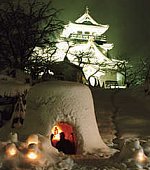 Kamakura Matsuri, Akita Prefecture Kamakura Matsuri, Akita Prefecture
Around February 15 - 17 each year.
Igloos (called "kamakura") are built with a small alcove inside dedicated to Suijin, who is honored during this festival to ensure good crops in the coming year. This festival has a history of over 400 years. See a few more photos here (Japanese-language site; photo shown here courtesy of same site).
- Toshigoi 祈年祭 Spring Festival. Held at various Shinto shrines in early spring to honor Kuni no Kotachi no Kami and pray for an abundant rice harvest.
- Suijin-sai, April 3, Funabashi Fishing Harbor (Chiba)
www.city.funabashi.chiba.jp/koho/eng/sankan/kyoge.htm
A festival to pray for a good fishing haul and safety at sea. All fishing boats from the area gather in the harbor with their flags streaming in the wind, and a "Kagura" ritual (sacred Shinto music and dance), dedicated to the god of the sea, is performed onboard the vessels. An important ritual since the Edo Period, the festival is called Funa-sai for short.
- Suitengu Spring Festival, Kurume City (Fukuoka), May 3 - 5
This annual festival, held at the Suiten-gu Shrine in Kurume City, is reportedly over 800 years old. Participants pray for safe and easy child birth, for protection from drowning, and to ask for the safety and health of children. This festival is also held at other Suiten-gu sites in Japan on May 5th. Another major festival in Kurume City is the Water Festival, which takes place from August 3 to 5.
- Okinohata Suitengu Festival, Yanagawa (Fukuoka), May 3 - 5
Held on the canal by the shrine for three days and nights, with about 30,000 visitors. Many pray for their children to be protected from drowning. Click here for more on the festivals of Kyushu.
- Gion Festival, Around July 25, Near Tsukuba (Ibaraki)
Anniversary feast of Suijin-gu Shrine of Tsuchiura City (Ibaraki). Water is splashed over the portable shrine.

SUIJIN SHRINES AND PLACES OF WORSHIP
- SUITENGU SHRINE IN KURUME, FUKUOKA 水天宮
www.yomiuri.co.jp/dy/edo/edo024.htm 2010 (no longer available online)
Suitengu Shrine in Kurume, Fukuoka, is the main shrine of all Suitengu shrines in Japan, particularly famous as the home of the deity of safe and easy childbirth. The shrine also holds the Anzan Kigan ritual -- literally "blessings for safe birth by expectant mothers." The Suitengu Shrine in Kurume is dedicated to the late emperor Antoku, his mother (Kenrei Monin) and his grandmother (Taira-no-nii-no-ama) who was a priestess. From the tragedy of the Dan-no-ura battle, the shrine is widely believed to be the god which protects ships and boats, prevents drowning, and eases childbirth. Kurume, in a southwestern part of Fukuoka, lies in the Chikushi Plain surrounded by the Minou mountain range, with Chikugo-gawa River running through the plain. There are many old temples and shrines dedicated to the God of Water and the God for Easy Birth. <Last two sentences quoted from The Japan National Tourist Organization (site last accessed Dec. 2, 2011)>
- TSUKIJI SUIJIN SHRINE, TSUKIJI FISH MARKET, TOKYO
metropolis.japantoday.com/tokyo/546/feature.asp (no longer online).
See similar story at archive.metropolis.co.jp/tokyo/546/feature.asp (last accessed Dec. 2, 2011)
Along the northeastern edge of the fish market stands a small Shinto shrine dedicated to Suijin-sama, the god of water, who is the patron deity of this fish market and also is enshrined in many domestic kitchens as an essential household god.
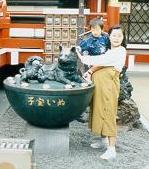 SUITENGU SHRINE 水天宮, NIHOMBASHI, TOKYO SUITENGU SHRINE 水天宮, NIHOMBASHI, TOKYO
www.suitengu.or.jp (Japanese). In 1818, a branch of the original Suiten-gu Shrine in Kurume City, Fukuoka, was built in Edo (present day Tokyo), but it was moved to its present location in Nihombashi around 1872. This shrine embodies the Water Deity who brings smooth delivery of babies, protects children, and protects against drowning (安産・子授ける). Like other Suiten-gu Shrines, it holds it annual spring festival on May 5th, which is its busiest day of the year. Benzaiten (the Buddhist goddess of fortune), is honored here as well. She is one of Japan's Seven Deities of Good Fortune. This shrine is also one of the sites on a local pilgrimage to the seven.
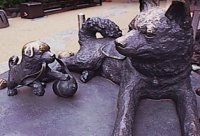 Another attraction of this shrine is its "Dog Deity," said to grant easy child delivery to those who touch it. Some say it embodies Oinari-sama, the god of rice and agriculture, whose messenger is the fox. Another attraction of this shrine is its "Dog Deity," said to grant easy child delivery to those who touch it. Some say it embodies Oinari-sama, the god of rice and agriculture, whose messenger is the fox.

|
|